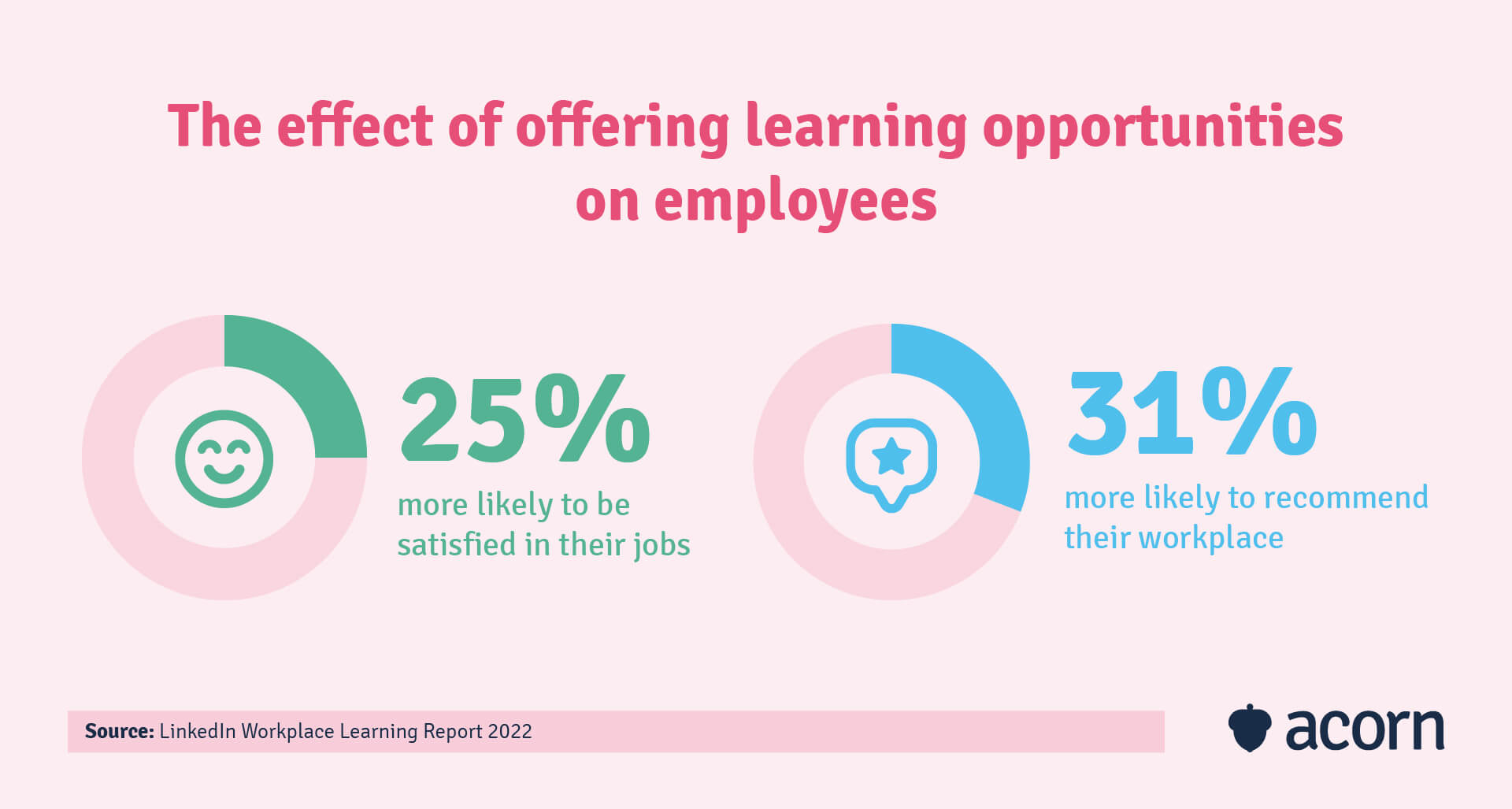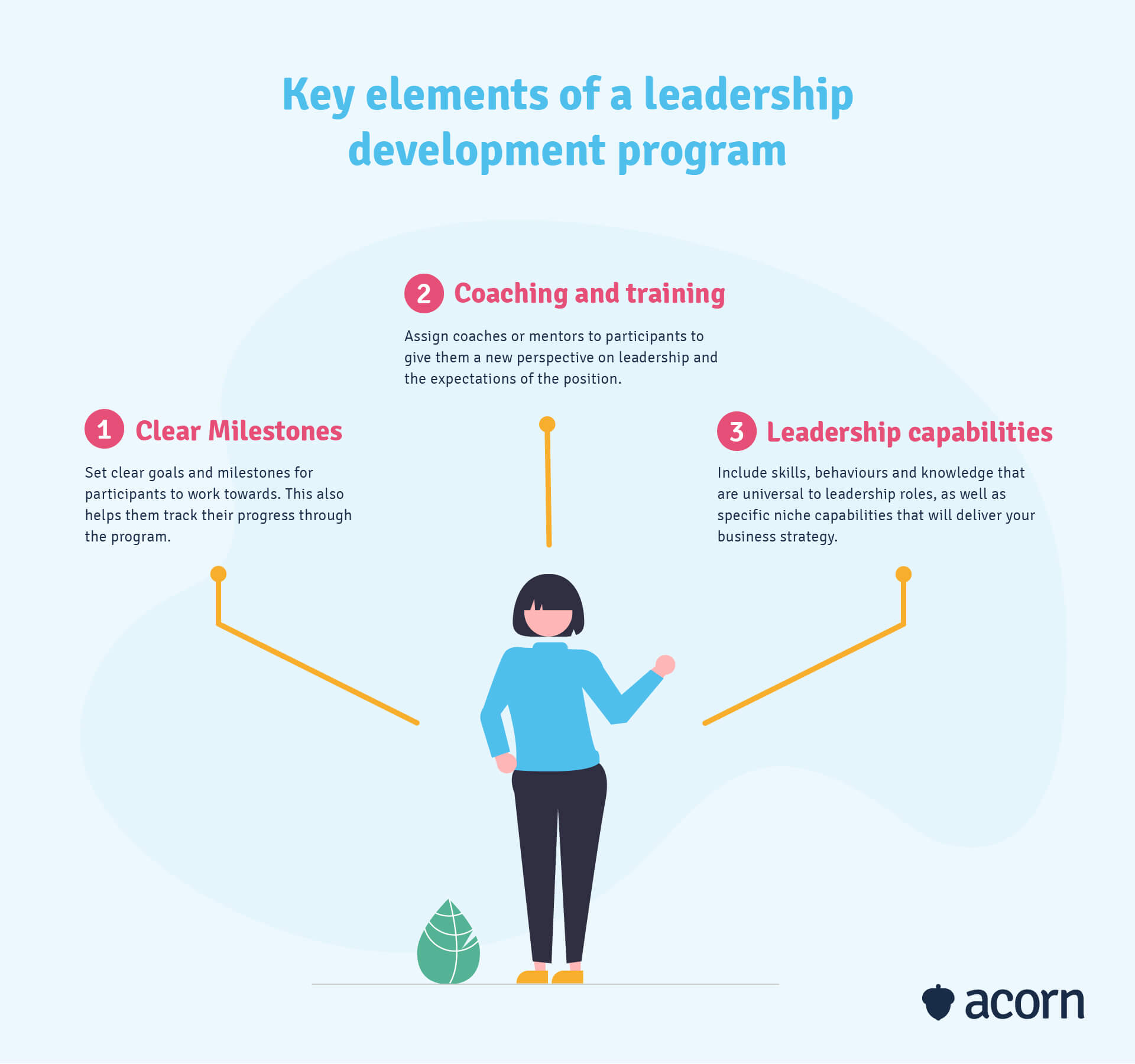Why a Leadership Development Program Improves Business Agility
Reading Time:

Lead the pack with the latest in strategic L&D every month— straight to your inbox.
SubscribeWhen it comes to finding future leaders, you should look no further than your current workforce.
This isn’t to say that external hires and the new knowledge and perspectives they bring are bad for your organisation, but sometimes you need someone who already has prior expertise in a particular area to join your leadership team.
Leadership development programs can help with this, giving employees the opportunities to train for leadership roles and develop the best leadership style for your organisation’s culture. In this article we’ll explore how to create a leadership development program and measure its impacts.
What is a leadership development program?
A leadership development program is a course or process used by organisations to train your employees for senior positions as leaders and managers. It seeks to build the capabilities of your future leaders by instilling them with the skills, behaviours and knowledge a leader in your organisation needs to head teams, tackle business challenges and drive the company towards strategic objectives.
What is the purpose of a leadership development program?
At its core, a leadership development program is designed to push capability development in employees to develop their leadership skills. It should empower your employees to become competent and confident leaders.
A good leadership training program should:
- Improve employee self-awareness
- Drive effective leadership skills
- Promote problem solving.
Not having a leadership development program in your organisation means your talent supply chain may not be secure. Leadership development prepares your workforce for future industry changes, so not having a set leadership program can mean your talent pipeline will lack the agility to adapt to expected and unexpected changes in the industry.
What are the benefits of a leadership development program?
Leadership development is more than just choosing who your team leaders will be. It’s about developing the behavioural change necessary for effective leaders to drive positive change in your organisation, delivering a number of benefits.
Drive strategy and productivity
Your business strategy should be aligned with your leadership strategy for the best organisational results. A leadership development program enables you to create this alignment as you’ll have control over its execution, eliminating conflicting priorities between teams and leaders and instead promoting a deeper understanding of your organisation’s business priorities. When your employees go through a leadership development program to build their capabilities, their individual performances as leaders is increased by 40%.
In short, control over your leadership development program allows you to drive the cultural and strategic intent you desire for your organisation.
Boost engagement and morale
Leadership development programs provide key people with new skills that support their ability to lead, allowing them to become effective leaders and managers. They will learn the leadership skills necessary to coach, motivate, influence and encourage their team members in their work, increasing morale as they do so.
High morale also means that your employees will be engaged, and therefore more likely to give feedback. This is an essential aspect for leaders as it allows them to work on their personal and professional development within the company.
Identify your future leaders
Your current employees already have knowledge of the different functions and processes that keep their team and the wider business operating. So, it goes without saying that hiring high-potentials from your internal talent pool is a more efficient way of filling leadership roles. Not only in terms of reducing onboarding costs, but in reducing time to proficiency, too.
Leadership development programs include organised activities that allow emerging leaders to shine–and allows their managers to identify them.
Attract and retain talent
Employees and potential employees prefer to work in organisations that allow for upward mobility. That is, they don’t want to take a role with no chance of promotion or learning.
LinkedIn’s 2022 Workplace Learning Report revealed that opportunities to learn and grow are the biggest factor in employees considering their workplace an “exceptional” work environment, which made them 25% more likely to be satisfied at work and 31% more likely to recommend their workplace. In past years, the report has shown that 94% of employees would stay with their organisations if there was investment in their professional development.

Providing leadership or personal development programs shows potential candidates that your organisation values its employees. It also means that your current employees are less likely to seek opportunities elsewhere when your business offers relevant opportunities already.
Key elements to include in a leadership development program
There are some elements that are key for effective leadership development programs to ensure employees get the most out of them, both as participants and as leaders in the future.

Clear milestones
You need to set clear goals and milestones for your leadership development program so that your participants know their progress is on track. When we talk about setting milestones, we don’t mean setting the one goal of completing the leadership development program. We’re talking about setting smaller, measurable and attainable goals throughout the process so that participants can have small victories along the way.
Think competencies achieved both in individual skills and capabilities as a whole, behavioural changes, and understanding of new expertise. These short-term milestones can be measured with assessments along the way. Not only does it build engagement in the program, but it also makes it easier to keep up with learning and track progress along the way.
Coaching and training
Assign a coach or mentor to your participants. One-on-one coaching, whether formal or informal, is a great way to give employees hands-on experience and show them the day-to-day responsibilities of senior leaders. Experiencing a leadership role gives employees a broader business perspective—something they don’t have exposure to in their current roles. This makes the expectations of leadership positions clear for your participants to see while simultaneously being guided towards leadership skills by their coaches.
With ongoing support, your participants will be the mentors to a future generation of leaders, so you should put the effort into instilling them with the necessary coaching skills now.
Leadership capabilities
Your leadership development program is where you should start to cement leadership capabilities in your future leadership bench. Think of universal leadership skills like as well as more niche capabilities that are specific to your business and its strategy.
Accountability
Great leaders model and hold themselves accountable, instilling accountability for one’s actions in their team members. Thus, you should be training your leadership potentials to embody this skill in their development so they can build a culture of responsibility and accountability in their teams.
Communication
We know it sounds cliché, but this really is important. A strong leader is able to communicate clearly and effectively with their team, otherwise they can’t exert their influence or convey business strategy to them. You need to ensure your leadership potentials are trained in effective communication methods to build an open and efficient team culture.
How to measure the results of a leadership development program
You need to make sure your leadership development program is actually effective, and that means measuring its impact on your organisation. Let’s break down the different steps to measuring leadership development results.
Tangible goals
Just like setting goals for your program participants, you need to set clear goals for your development program. Ask yourself why you are implementing a leadership program.
Write down the tangible effects you expect to see as a result of your training program. These should be outcomes that will have a significant impact on your business.
These outcomes could be things like:
- Reduction in employee turnover
- Increased satisfaction rates in employees.
Assessment criteria
Decide the performance criteria you’ll be assessing against in your leadership training program. If you don’t set these criteria before you implement your development program you won’t have specific learning goals to meet and will not be able to measure results in a meaningful way.
Consider the following criteria for assessment:
- Leadership skills relevant to your particular area or industry
- Leadership capabilities in line with individuals’ professional development plans.
Evaluate continually
Don’t just wait until the end of your leadership development program to gather feedback on how it went. You should keep an open line of communication with participants, mentors and other individuals involved in its execution at all stages of the program to ensure that it’s tracking smoothly and meeting your set goals.
The scope of your feedback should cover whether employees are engaged with their learning (this is where an LMS can help) and whether the program is meeting learning objectives. The idea is for continuous improvement in your program’s execution to ensure a smooth and engaging learning process for your employees.
The ROI on your leadership program should do the talking for you here. A recent study found that businesses have an ROI of 25% within three months of training.
This is why we created the first performance learning management system (PLMS) here at Acorn. It’s a dynamic, AI-powered platform that aligns your L&D efforts with business performance, revealig the true results of leadership development programs.
Challenges of leadership development programs
Leadership development programs aren’t always straightforward.
As always with workforce planning and L&D activities, resourcing and relevance are the greatest obstacles you need to overcome. And, unfortunately, these challenges tend to feed off each other.
Most companies, especially small ones, don’t have the time or the money needed to produce an extensive, well-rounded and relevant leadership development program. This means they depend on ready-made programs that just don’t fit with their organisational needs. Essentially, they aren’t relevant to the unique challenges your business faces in its leadership training.
Plus, not having a tailor-made program to align with your business needs means that your leaders will lack the leadership skills and style needed to drive company culture, performance and strategy. Which means your returns—and therefore, resources—will be lacking, thus feeding the cycle.
The bottom line
It’s better to stop the lack of resources to irrelevance pipeline before it begins, by ensuring you have a leadership development program built specifically for your organisation and its unique situation.
A lack of time and money doesn’t have to hold you back here. Consider using an LMS or other software that saves you the time you would have spent developing a program, but allows for customisation to suit your needs.
Key takeaways
For employees, leadership development, like any professional development, is an important aspect of their career growth. So much so that employees don’t want to work for organisations that deny learning opportunities. Not only this, but an unhealthy talent pipeline can leave your business open to risk as the industry changes over time.
This is where you can use a leadership development program in your company to increase employee satisfaction and retention, reduce your hiring costs, and ready your employees for the future.
There are two important factors to remember when building or using a leadership development program.
- Set goals for participants and for the program itself.
- Improve continually. Utilise feedback to develop an efficient leadership development program.
Remembering these factors will allow you to create a learning program that will benefit your employees’ professional development and your business’s ability to meet strategic priorities.